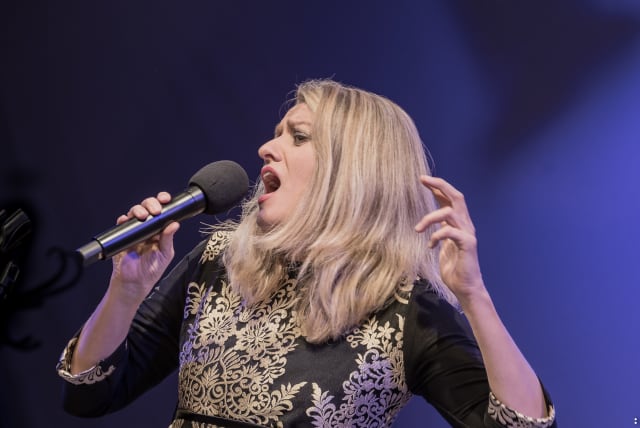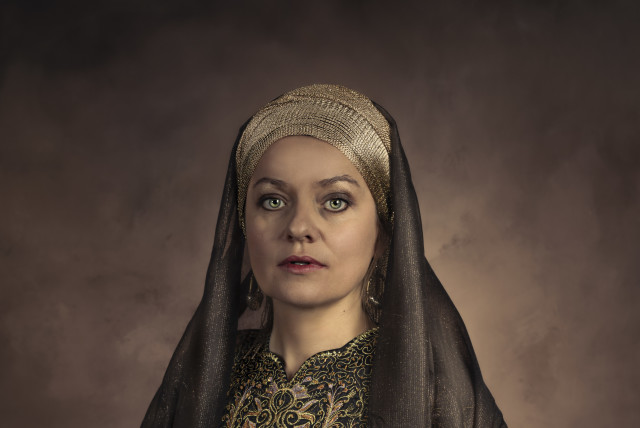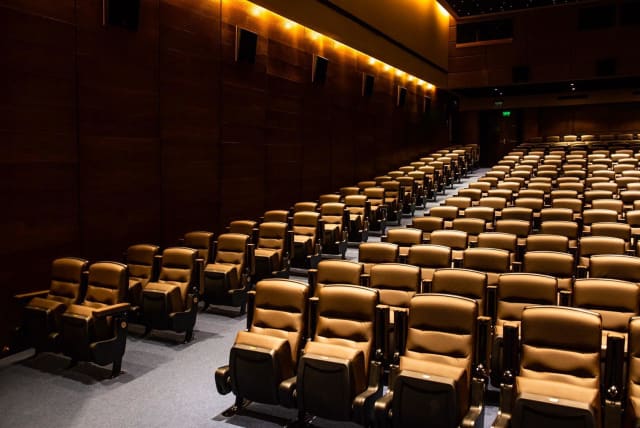What have Zen meditation practices, Auschwitz, and Yiddish songs got in common? In a word, or two, Olga (Avigail) Mieleszczuk.
Forty-something Mieleszczuk is a Polish-born singer who performs a wide repertoire of Yiddish numbers all over the world. Now she brings her A Meydele fun Poyln (“A Girl from Poland”) show to Confederation House (July 4, 8:30 p.m.), along with the other members of her quartet: longtime sparring partner multiple wind instrument player Ittai Binnun; now Jerusalem-based Ukrainian accordionist Artem Nizhnik; and violinist Aliza Keren. The concert title is self-explanatory, but Mieleszczuk brings more, much more, to the performance fray.
For starters, she was not born Jewish.
“My whole Jewish journey began at Auschwitz,” she declares when I inquire how her forebears survived the Holocaust in Poland. As epiphany venues go, that takes some beating. She got some help from an extraneous spiritual direction. “Back then, I did Zen meditating, and I heard about an organization called Zen Peacemakers that held five-day gatherings at Auschwitz. It was aimed at providing some healing for the place.”
That it wasn’t easy goes without saying. It wasn’t meant to be.
“They purposely hold the retreats in November, when it is cold and rainy. You sit outside on train tracks, at Birkenau-Auschwitz or Treblinka, and meditate, and they read out names of victims.” There were also chants in Hebrew, such as “Shema Yisrael” (“Hear, O Israel”) and “Ani Ma’amin” (“I Believe”), which refers to the 13 articles of faith devised by the Rambam in his commentary on the Mishna. “At the time, I didn’t understand the words I was chanting,” says Mieleszczuk, now a fluent Hebrew speaker, close to 14 years after making aliyah.
Still, she got the spiritual intent and it set some wheels in motion. “That drew me closer to Judaism. I had never thought about Judaism before that.” Mieleszczuk notes she was not exactly bucking the religion transition trend. “A lot of people connect to Judaism in the context of the Shoah,” she explains, adding an oxymoronic element to the shift. “They discover there is a living world through dead people,” she smiles grimly. “That doesn’t sound too good, but it’s true.”
It didn’t stop there for Mieleszczuk. Her interest and heart were piqued, and she reverted to an earlier stage of her personal growth.
“I began working with Yiddish theater,” she says. “I’d taken a break from music and the arts – I studied sociology, psychology, and anthropology.” That was a master’s degree at the University of Warsaw and followed a BA in classical music from the Chopin University of Music in Warsaw. “I became interested in Jewish culture,” she states.
Her initial training in the arts came from a very different neck of the woods to her current field of interest. “I played classical piano. I played Chopin, Bach, and all the rest.” There was some down-and-dirty commercial input, too. “I was also a little into rock music. I liked The Doors. That was a bit underground, subversive,” she chuckles. She eventually learned to play the accordion as a user-friendly way of accompanying her own vocals.
It took a while for her to get a decent grasp on Judaism, and the barbarism of the Nazi death machine. “We didn’t really learn about the Holocaust at school,” she recalls. “They told us, yes, that Jews had suffered and been murdered, but so had the Poles. The way they explained it to us was that the Poles had suffered from the Nazis just as much as the Jews.”
Presumably, Mieleszczuk and her classmates were not enlightened about Poles murdering Jews, including after the end of the war. “No,” she replies. “There was nothing about that.”
That certainly follows the contemporary political line in Poland, where there is a law that makes it a crime to blame Poland for crimes committed during the Holocaust, not to mention the continued staunch refusal by Poland to compensate Holocaust survivors and their descendants for property confiscated from Jews during World War II.
Mieleszczuk notes that there is room for improvement in this country, too. “In the Israeli education system, they don’t talk much about how much Poles suffered. There were the two extremes – the Poles who murdered Jews, and those who heroically saved Jews. They [Israeli students] don’t know the statistics.”
Indeed, currently, Poland tops the Righteous Among the Nations list, with 7,232 Poles recognized by Yad Vashem for their bravery and kindness toward Jews during the Holocaust. Next comes the Netherlands, with almost 6,000. However, if you consider that there were around 3.5 million Jews living in Poland before the war, and just 140,000 in Holland prior to Nazi occupation, that puts a very different slant on the figures. Still, as Mieleszczuk argues, there were thousands of Poles who put everything at risk to keep Jews alive.
Closing the gaps
Clearly, Mieleszczuk had some ground to cover to unearth the facts and get closer to the spirit of her emerging religious horizons. How in the blazes is a non-Jewish Polish woman, born to a Catholic family, to close the yawning cultural, religious, and philosophical gaps between such divergent lines of thought?
Music was the natural lead-in. “I started learning Yiddish. Also Hebrew. But in Poland, Jewish music is Yiddish music, not Israeli music.” With such a massive pre-war Jewish community – Jews accounted for 10% of Poland’s population before WW II – that is no surprise, but the vibrant cultural life of the Polish Jewish community spread across a wide spectrum of genres and styles.
Over the past decade and a half, with five albums released to date in her rapidly expanding discography, Mieleszczuk has addressed some of that, featuring seemingly incongruous cultural content in her output. That includes tango, with her 2017 album Yiddish Tango Live in Jerusalem.
“Tango was very popular in Europe, and especially in Poland,” she says. “But it was a different kind to the original form. It was less sensuous and more nostalgic.”
Thousands of original tango songs were created in Warsaw of the 1930s, primarily by Jewish songwriters, and often with sumptuous klezmer colorings. She notes that the genre also had a high profile in pre-state Palestine. “The Jews that came here, before the creation of Israel, loved tango too.”
Mieleszczuk did her homework and, while she prepared for conversion to Judaism – which she eventually completed after making aliyah – she mined the rich seams of her native country’s Jewish cultural backdrop, researching the Jews’ disproportional role in Polish culture. That took in Ashkenazi Jewish music, particularly that from the Eastern Borderlands of Poland, as well as hassidic music and Yiddish folk songs.
She has been disseminating the word of Polish Jewish culture across the globe for some years now, performing in the United States, Canada, and all over Europe. She recently returned from an offshore tour which took in gigs in Sweden, St. Polten near Vienna, and Poland.
“It was a Holocaust-related show. It was a project with Canadians, with songs based on the diary of Molly Applebaum.” That references the memoir of the now-Toronto resident 93-year-old Holocaust survivor who was born in Poland with the name Melania Weissenberg. She and her cousin Helen survived for two years in a cramped wooden box, buried on land belonging to a Polish farmer who managed to provide them with meager, but life-sustaining, amounts of food and drink.
“It was very moving to perform in Poland, near where Molly lived, with this project of Yiddish songs,” says Mieleszczuk. “There is a beautiful restored synagogue there.”
Mieleszczuk does better business abroad than in her adopted country. “People are interested in Yiddish folklore and music in Europe and other places,” she explains. “When we played in Poland, we were made very welcome there, and we felt what we were offering them was very meaningful for them. There was a whole busload of senior citizens who came to the concert. Perhaps they were children during the war.”
Yiddish of the past, Yiddish of today
It is probably fair to say that Yiddish is largely viewed as something of a relic of the past.
Yes, the language is taught at places such as Bar-Ilan University, but it got bad press in Israel from the off. Yiddish was considered a language of the Diaspora, and Sabras viewed it as a reference to what they considered the weak will of Holocaust victims who did not do enough to resist the Nazis and allowed themselves to be slaughtered like proverbial lambs. Yiddish was not for the proud new Israelis who had their own country and, more importantly, their own army.
Hebrew was seen as the language of the strong free Jew, and any reference to the Holocaust was summarily shoved to one side. Indeed, back then there was a special tax imposed on any cultural venture based on foreign languages, which included Yiddish.
I wondered whether Mieleszczuk was perturbed by the average advanced age of her audiences and whether she was particularly eager to connect the younger generations to the glorious yesteryear Jewish culture of Poland. I was surprised, and a little perplexed, by her reply.
“What is important for me is to preserve this tradition. I don’t care who hears this music, or if anyone listens to it. I don’t do this for a particular audience. I have this mission to carry out, to honor those who were murdered.”
And she does that as a converted Jew, someone who joined the faith and is determined to keep the flame of the rich Jewish culture of her country of birth blazing as brightly as possible, and for as long as possible, around the world.
“After the mikveh, after I completed my conversion, I ran to a studio to record excerpts from the diary of [Jewish Polish painter] Gela Seksztajn. That was part of a new exhibition for the Auschwitz Museum.”
That also provided Mieleszczuk with some sense of coming full circle. “For me, that was closure. My Jewish journey began at Auschwitz – and I came back and recorded as a Jew. That was quite a few years ago, and not many people knew about the exhibition.” Seksztajn, her husband, and their infant daughter were murdered, it is presumed, during the Warsaw Ghetto Uprising in 1943.
There was recently more in the way of closure for Mieleszczuk. “I just went back to Auschwitz to meet a BBC journalist who did something on Yiddish tango.”
Tango will not feature too prominently in next week’s Confederation House show. Instead, the members of the audience will be entertained with a selection of Yiddish songs liberally laced with the heady resonances and ambiance of vibrant life in Polish shtetls across the ages. Should be quite a blast from the Jewish past.■
For tickets and more information:
confederationhouse.org/en/








































































































